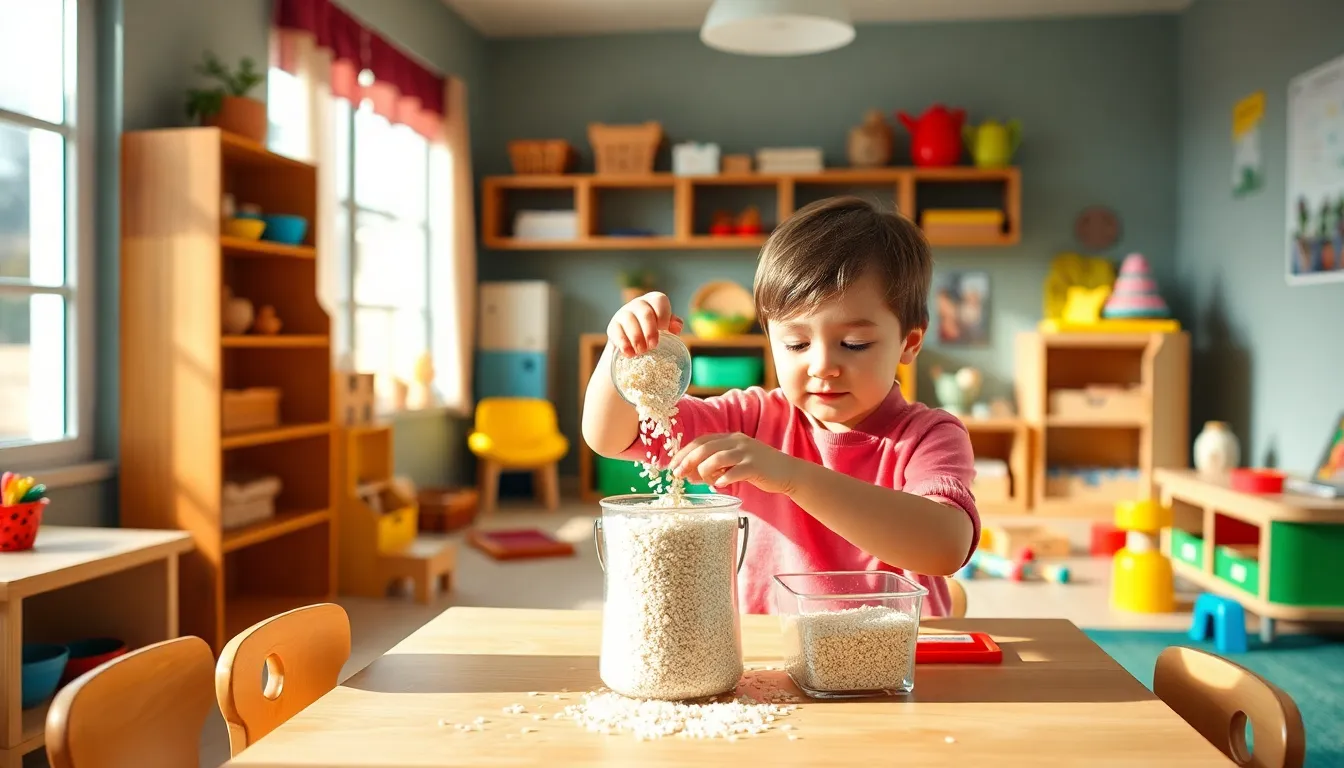Montessori learning materials are more than just tools; they’re gateways to a child’s exploration and discovery. Developed by Dr. Maria Montessori, these specially designed resources encourage hands-on learning, fostering independence and critical thinking in young minds. Each material serves a specific purpose, guiding children through essential concepts in a tactile and engaging way.
In a Montessori environment, children interact with these materials at their own pace, allowing for a personalized learning experience. From colorful wooden blocks to intricate puzzles, each item is crafted to enhance sensory perception and cognitive skills. As educators and parents increasingly recognize the benefits of this approach, understanding the role of Montessori materials becomes crucial in nurturing a love for learning that lasts a lifetime.
Table of Contents
ToggleOverview of Montessori Learning Materials
Montessori learning materials consist of various tools that facilitate interactive educational experiences. These resources include sensorial materials, practical life activities, language, and math tools, each serving distinct educational objectives.
Sensorial Materials
Sensorial materials refine children’s senses and help them organize experiences. Examples include:
- Color Tablets: Enhance color recognition and discrimination.
- Sound Boxes: Develop auditory skills through contrasting sounds.
- Cylinder Blocks: Foster fine motor skills and visual discrimination due to varying sizes.
Practical Life Activities
Practical life activities promote self-sufficiency and coordination. They encourage children to engage in everyday tasks, such as:
- Pouring: Improves hand-eye coordination and concentration.
- Buttoning Frames: Develops fine motor skills and independence.
- Sweeping: Teaches responsibility and care for the environment.
Language Materials
Language materials support literacy development through engaging exercises. Key tools include:
- Sandpaper Letters: Familiarize children with letter shapes and sounds.
- Moveable Alphabet: Encourages word formation and phonetic awareness.
- Reading Cards: Reinforce vocabulary and comprehension skills.
Math Materials
Math materials provide a tangible approach to mathematical concepts. Examples encompass:
- Number Rods: Introduce quantity and number relationships.
- Golden Beads: Illustrate place value and basic operations.
- Fraction Circles: Aid in understanding fractional parts visually.
Montessori learning materials cater to individual learning styles, ensuring children benefit from personalized educational journeys. Each material’s design encourages autonomy, critical thinking, and a deep-rooted passion for knowledge.
Types of Montessori Learning Materials

Montessori learning materials encompass a variety of tools designed to enhance children’s educational experiences. These materials foster hands-on engagement, exploration, and skill development across different domains.
Sensorial Materials
Sensorial materials refine children’s senses and promote cognitive development. Tools such as color tablets, sound boxes, and texture boards allow children to explore visual, auditory, and tactile stimuli. For instance, color tablets enable children to discern differences in hue and saturation, while sound boxes help them differentiate various sounds, fostering auditory discrimination skills.
Practical Life Materials
Practical life materials teach children essential life skills and promote independence. Activities like pouring, sweeping, and buttoning frames encourage coordination and concentration. For example, using a pouring activity not only develops fine motor skills but also instills a sense of responsibility and self-sufficiency. These activities mirror real-life tasks, enabling children to gain confidence in their capabilities.
Language Materials
Language materials support literacy development through interactive and engaging methods. Tools such as sandpaper letters, moveable alphabets, and reading cards provide concrete experiences with language. Sandpaper letters promote letter recognition and phonetic awareness, while moveable alphabets allow children to construct words, reinforcing their understanding of language structures and vocabulary.
Math Materials
Math materials offer tactile experiences to grasp mathematical concepts effectively. Resources like number rods, golden beads, and bead frames help visualize numbers and operations. For example, golden beads allow children to understand place value through hands-on manipulation, making abstract concepts more concrete. These materials engage children in mathematical exploration, promoting a deeper understanding of numerical relationships.
Benefits of Montessori Learning Materials
Montessori learning materials offer numerous advantages in child development. These benefits include enhancing independence and fostering creativity.
Enhancing Independence
Montessori learning materials promote self-directed learning, allowing children to choose activities that interest them. This autonomy leads to increased self-confidence and decision-making skills. With each material, children engage in purposeful work, fostering a sense of responsibility for their own learning process. Activities like practical life exercises enable children to master daily tasks, developing fine motor skills and self-sufficiency. As children gain independence, they become more adept at solving problems and adapting to new challenges.
Fostering Creativity
Montessori learning materials stimulate imaginative thinking through hands-on exploration. Children interact with diverse resources that encourage open-ended play and experimentation. Sensorial materials, for example, invite children to explore textures, colors, and sounds, sparking creative expression. Language and art tools provide opportunities for storytelling and creative writing, allowing children to communicate ideas in unique ways. Such engagement nurtures innovative thinking and inspires children to think outside the box while developing their artistic abilities.
Choosing the Right Montessori Learning Materials
Choosing appropriate Montessori learning materials involves several key factors. Evaluating the purpose and goals of the materials facilitates informed decisions. Each material serves a specific educational objective, providing clarity on its intended use.
- Age Appropriateness: Select materials suited for specific developmental stages. Ensure materials align with children’s cognitive, physical, and emotional growth. For example, younger children benefit from simple sensorial materials, while older children engage with complex math resources.
- Skill Development: Choose materials that foster specific skills such as motor skills, language acquisition, or mathematical understanding. For instance, practical life activities like transferring objects help develop fine motor skills and concentration.
- Engagement Factor: Identify materials that capture children’s interest. Engaging materials enhance motivation and promote exploration. Materials with bright colors, varied textures, or interactive components often attract children’s attention.
- Quality and Safety: Ensure materials are made from durable, non-toxic materials suitable for children’s use. High-quality materials withstand wear and tear from frequent handling, maintaining their educational value.
- Cultural Relevance: Incorporate materials that reflect diverse cultures and experiences. This approach enhances inclusivity and fosters a broader understanding of the world, enriching children’s learning experiences.
Implementing these criteria facilitates effective selection of Montessori learning materials, optimizing their educational impact on children’s growth and learning.
Montessori learning materials play a crucial role in shaping a child’s educational journey. By fostering independence and encouraging self-directed exploration, these resources create an environment where children can thrive. Each material is thoughtfully designed to enhance specific skills while promoting a love for learning.
As more educators and parents embrace the Montessori approach, understanding the value of these materials becomes essential. They not only support cognitive and emotional development but also inspire creativity and critical thinking. Choosing the right Montessori materials can significantly impact a child’s growth and overall learning experience, paving the way for a bright future filled with curiosity and discovery.




